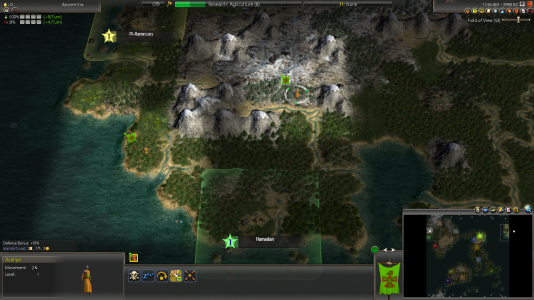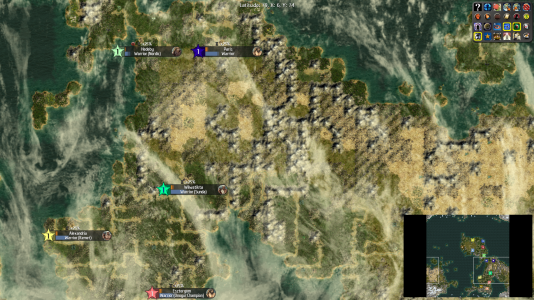I'd say that while it's fair for a certain situation, that's an overly narrow view. In my experience, a city in medieval era is more likely to hit a "hard cap" through

rather than a "soft cap" through

. A city that hit a

cap would be looking to maximise its production, and might not actually have enough purely production tiles to work. This, combined with the civic that buffs craftsmen that arrives with the same tech, makes craftsmen as a production source a viable option for the first time. The equilibrium is of course shifted further for an Industrious leader, and even further later on with Protectionism. Also note that your +1

calculation is only true for an established city. Any new city would not have a warehouse.
It's mildly surprising that you would find

more of a growth restriction than

in the medieval era, generally speaking! With monarchy and a religion (especially if coupled with traditional custom),

is actually rather abundant in my experience, and your baths being the only available boost to

outside of resource variety (harder to come by earlier on when wide expansion is generally more unfeasible), makes reaching that harder to do if being mindful of not exceeding

, because preserving forests as one player-controlled means of dealing with this reduces farm acreage and consequently an abundance of

at this stage of the game.
Admittedly, it could be that I am much more conservative with chopping forests than most players, perhaps. I anticipate industrial era

considerations when planning core cities I intend to eventually become major

centers, and often try to preserve 4-6 forests in these key cities' BFCs (knowing how much

efficiency per farm will explode later on to feed the craftsmen at this time, and that clearing the land for farms will result in a low early/mid industrial ceiling when lost

from

and death from epidemics offsets what is gained by more farming), but then again my preferred playstyle is also one of limited growth and somewhat tall development through midgame, with a strong preference for late war, post-industrialization. That could be the reason that my

cap tends to be lower in the medieval era, where several players seem to prefer wide conquest (and thus, plenty of bonuses to rake in the

); I just find that era to be typically much more favorable to the defender in warfare (with cavalry dominating the field and

penalties for the attacker giving defending cavalry pride of place in choosing the field of battle), so, while I have butchered through longbow castle cities pre-gunpowder when really compelled to (and even then, you're going to need some kind of special doctrine or situationally-specific UU), it's definitely not something I aim for in medieval, and classical expansion to this scale is most often economically impossible due to the weak

infrastructure that is available then.
So yes, while your assessment holds for some situations, it is far from universal, as it hinges on the premise that

is the limiting factor - which may be true in some cases, but far from universal. But you are correct in that it is far from an automatic build. That said, and acknowledging your caveat of not asking for a buff, its utility did always feel a bit too marginal to me (along with the later manufactury), especially given that, as you correctly point out, it does come with a malus. I will revisit it, with a special emphasis on AI evaluation (as AI does tend to undervalue buildings that come with maluses).
Yes, actually the manufactory also feels rather weak to me, for similar reasons. I truly wasn't expecting or soliciting any kind of revision, but good to see, in any case!
Also, I just downloaded the SVN and intend to continue playtesting! I'm excited to see some of the aesthetic changes in play and experiment with the new cavalry/city dynamic.
You are arguiing how useful and powerful cash rushing is. I agree that it useful and seems scaled correctly compared to production with hammers which is still a bit cheaper. What I am saying is that production gained through upgrading a unit is twice as cheap, twice as powerful.
It looks like I actually misunderstood what you were referring to. I thought you were referring to hurrying production with gold, rather than a cost difference in upgrading with respect to scaling costs. My bad! I think what I said above still applies in the case of the former, though.
By the way, I don't plan to descale the costs of spies.
Ah, and yes, I forgot when writing this that you had wanted to make a caveat for spies when disabling the rest of the units' scaling costs. No intention to misrepresent what you said or put words in your mouth! As far as the scaling costs overall goes, however, I've gone back and forth on this one too, most prominently under the logic you mention, but I think the way that it softly models manpower (and the other various restrictions that Walter argued for) I find ultimately compelling and satisfying, especially so since the "Hearts of Iron 3 practical" argument is only applicable towards the end of the game anyway, and even that doesn't account for these other mentioned peripheral necessities.
From a sheer gameplay standpoint, I think it has an enormous impact in making overexpansion particularly challenging (which is actually rather fun, I can say from experience, when you win domination in spite of these difficulties), and it's historically plausible within the "sweet spot" of abstracted realism that this mod so excellently models, in my opinion.

 ).
). 
 rather than a "soft cap" through
rather than a "soft cap" through  . A city that hit a
. A city that hit a  calculation is only true for an established city. Any new city would not have a warehouse.
calculation is only true for an established city. Any new city would not have a warehouse.
 outside of resource variety (harder to come by earlier on when wide expansion is generally more unfeasible), makes reaching that harder to do if being mindful of not exceeding
outside of resource variety (harder to come by earlier on when wide expansion is generally more unfeasible), makes reaching that harder to do if being mindful of not exceeding  at this stage of the game.
at this stage of the game. penalties for the attacker giving defending cavalry pride of place in choosing the field of battle), so, while I have butchered through longbow castle cities pre-gunpowder when really compelled to (and even then, you're going to need some kind of special doctrine or situationally-specific UU), it's definitely not something I aim for in medieval, and classical expansion to this scale is most often economically impossible due to the weak
penalties for the attacker giving defending cavalry pride of place in choosing the field of battle), so, while I have butchered through longbow castle cities pre-gunpowder when really compelled to (and even then, you're going to need some kind of special doctrine or situationally-specific UU), it's definitely not something I aim for in medieval, and classical expansion to this scale is most often economically impossible due to the weak  infrastructure that is available then.
infrastructure that is available then.

 .........
.........